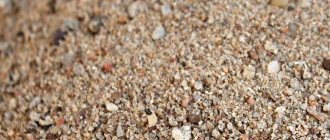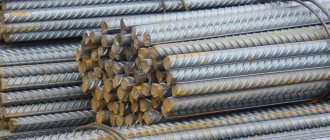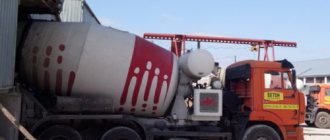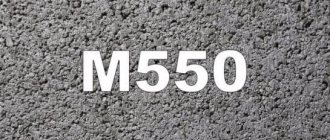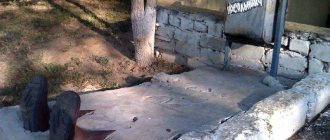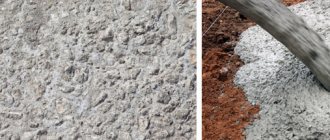Methods for forming art concrete
Arch concrete is formed in several ways, depending on the method of work, the tools used, the principles of influence and the scope of operation.
Basic methods for forming archstone:
1. Stuffing (tamping) - the solution is poured and then tamped with a stick or rod (handmade). This is how the most complex, rigid decorations are created.
2. Pressing - mostly thin-walled, frost-resistant and durable, parts are created using molds and hydraulic presses.
3. Vibration pressing – pressure during vibration. The work is carried out using a mold and a vibropress. This is how paving slabs and paving stones are made. The objects are durable, easy and quick to manufacture, and the process is relatively inexpensive.
4. Casting – the solution is poured into molds on vibrating platforms; it is possible to use deep vibrators. The products are inexpensive, but not of very high quality.
5. Embossing - work is performed using matrices used to obtain the desired texture of the base. The technology is often used when finishing areas, paths on the territory, and when decorating vertical surfaces of structures and buildings.
Production
To obtain the desired MB composition, the sand is sifted in 3 stages, and then mixed in the proportions given in the table:
| Fraction, mm | Content, % |
| 5—1,25 | 57—63 |
| 1,25—0,315 | 17—23 |
| 0,315—0,14 | 17—23 |
Mixing of dry components is carried out in a ratio of 1:1.5 to 1:3.5, then water is added in an amount determined by the requirement for the plasticity of the mixture. If necessary, dilute and add plasticizer
It is important to understand that an increase in the fraction of coarse aggregate will lead to a loss of concrete strength, and an increase in the proportion of fine sand will lead to an increase in the volume of cement used, but also to achieving maximum strength indicators. To improve the quality of the solution, it is compacted by pressing, roller method, vibrocompression or tamping.
Scope of application
The use of MB is determined by the absence of open rock deposits with the presence of large fractions in the area where cement-sand mixtures are produced.
Delivery of crushed stone or gravel to remote areas significantly increases the cost of concrete, which affects the cost of the final product. This reason is the most common when deciding to produce concrete using fines.
In addition to purely economic reasons, there are many products and structures that cannot be produced using traditional concrete with large fractions. These include:
- asphalt concrete pavement;
- concrete pipes of large and small diameter;
- structural elements for the construction of hydraulic structures;
- pipes with special properties for draining aggressive water;
- any thin-walled reinforced structures (for example, spherical products are cast from MB, which have high strength and, at the same time, low weight);
- floor slabs for equipping canopies in agricultural buildings where it is necessary to cover large spans;
- bunker structures, large containers for storing bulk and liquid substances and materials;
- products with dense reinforcement;
- arched structures capable of covering large spaces (for example, when equipping exhibition pavilions).
Architectural concrete manufacturing technology
It is quite possible to make an architectural one, having determined the composition in advance in accordance with the required characteristics and properties. First, all components must be sifted through a sieve to avoid lumps. Then mix the filler (quartz sand, crushed stone, other materials) and cement, add pigment and special mixtures that enhance the desired properties.
You should get a homogeneous dry mass. They make a hole in it and fill it with water. The proportions of materials depend on the purpose of producing art stone and the brand of cement, but the volumes for the most common brand M-500 are indicated above. Further, various material processing techniques can be used.
Methods for designing architectural concrete:
Sputtering
This option is suitable for processing vertical surfaces. To perform the work, an acid dye and a special spray are used. The paint is applied sequentially, in layers, onto the concrete solution, achieving the desired shade.
Screen painting
This is how large flat surfaces are treated. Stencils can be bought ready-made in specialized stores or made independently from any suitable sheet material. This is how various patterns and brickwork are often made.
Stamping
A common method for processing vertical and horizontal planes, using matrices made of silicone or rubber. The stamps are coated with moisture-resistant additives and pigment, and then pressed into concrete to achieve the desired effect. After hardening, the surface of the matrix is removed, and protective impregnations are applied to the finished concrete.
It is necessary to prepare architectural concrete, the production technology of which is quite simple, only if all proportions and components are accurately calculated. In this case, further processing and design allow you to achieve an ideal result.
Application area
Most often, fine-grained concrete is used in residential areas where there is a shortage or absence of coarse aggregates (gravel, crushed stone, etc.). This avoids the high financial costs of shipping traditional ingredients in larger sizes. Road surfaces, pipes, various water treatment systems and other hydraulic structures are made from such raw materials.
Among them we can list such as domes, vaults and shells. Moreover, despite the small wall thickness, such structures will have a high load-bearing capacity, be light and relatively inexpensive.
In addition, fine-grained mortar is used for buildings with large spans, which are used for storing bulk materials or various liquids (concrete tanks, bunker-type structures, silos, etc.). It can also be used for the construction of arched structures, which have recently been in great demand for the construction of exhibition complexes.
Composition and types of fine-grained concrete
The main difference between fine-grained concrete and other types of artificial stone is, of course, its composition. No coarse aggregate is used in its manufacturing process. Thanks to this technique, the final product acquires a homogeneous structure with a specific surface area of solid mass and high porosity.
Main components:
- Portland cement or fine-grained cement. The latter is used in cases where the production of any reinforced products and structures is required.
- Fine-grained filler. Various materials can act as it. For example, crushed lime or ordinary ash. But, most often, sand of large fractions is used. When using fine sand, it is enriched with crushed gravel.
In addition to the key components, depending on the planned area of application of concrete, a unique component is added to it, which gives the artificial stone special properties. It is the introduction of such materials that makes it possible to classify fine-grained concrete into various types.
Reinforced
In addition to using the main components of fine fractions, during the production process the finished mortar is additionally reinforced with masonry mesh. This tandem gives the final product strength that works well in both compression and bending. This type of fine-grained concrete is actively used in the construction of load-bearing structures of small thickness.
Silicate
To increase the resistance of products to the effects of a humid environment and high temperatures, calcium silicate is introduced into its composition. Ordinary fine-grained concrete can easily withstand temperatures up to 300 C, and the similar ability of structures based on liquid glass increases almost 4 times.
High strength
To increase the strength characteristics of fine-grained concrete, additional plasticizing additives with narrowly targeted action are introduced into the composition. To increase the effect they create, instead of the usual filler, glauconitic sand is used.
Modified
Special additives are added to the composition of modified concrete. Only now they are selected from a number of modifying chemical compositions that can improve all the performance characteristics of the material to the maximum level. Using them in different proportions allows you to “play” with the structure of the artificial stone each time achieving the desired properties and characteristics.
Fine aggregate
It is sand - a product of natural destruction or crushing of rocks that meets the requirements of GOST.
The most important qualitative characteristic of sand is its grain (granulometric) composition, which affects all the properties of concrete, especially high-strength concrete. The grain composition of sand especially strongly influences the technological properties of the concrete mixture - its mobility, rigidity, workability and formability, which are reflected in the consumption of water and cement in concrete, the compaction coefficient of the mixture with the available equipment. An optimal combination of specific surface area and sand size is required.
Sand (with a grain size from 0.14 to 5 mm) is introduced in the smallest quantity, at which the mortar part of the concrete mixture receives the viscosity necessary to maintain crushed stone or gravel in suspension during transportation and laying. To obtain the same viscosity of the solution, different amounts of sand can be added to the same amount of a given cement glue, depending on its properties; The glue and excess water in it are placed on the surface of the grains. Therefore, the value of the latter per unit volume of sand (specific surface) and the size of its grains are of significant importance - with fine sand, more cement glue is required.
To reduce the amount of glue in concrete, it is also necessary to take into account the voidness of the sand, i.e., the volume of its intergranular space, expressed as a percentage (of the volume of sand); the lower it is, the less cement adhesive is required in concrete.
Characteristics of the grain composition of sand are its fineness modulus (Table 1) and sieving curves (Fig. 1).
| Sand group | Total residue on sieve No. 063 by weight, % | Size modulus*, Mk | Specific surface area, cm2/g | Passes through sieve No. 014 but weighs. % |
| Large | More than 50 | More than 2.5 | — | To 10 |
| Average | From 35 to 50 | 2,5—2,0 | — | To 10 |
| Small | — | Less than 2.0 | 100-200 | Up to 15 |
| Very small | — | — | 201—300 | Up to 20 |
* The quotient of the sum of total residues on all sieves with openings of 2.5 to 0.14 mm divided by 100.
Usually, dust-like and clayey impurities contained in sand with a highly developed specific surface area and sometimes significant water absorption (swelling) sharply increase the viscosity of the solution and do not allow the introduction of a significant amount of sand into it. Therefore, the content of such impurities in sand for concrete of prefabricated structures of grade 200 and above is allowed no more than 3% by weight, including clay no more than 0.5%. In addition, the sand should not contain organic acids, the neutralization (saponification) of which requires free lime released during the hydrolysis of C3S cement.
Fine sand, previously dispersed into fractions, can be enriched by adding other sands with larger grains. These include sands that are natural or obtained by crushing stone into crushed stone from unweathered igneous, metamorphic or sedimentary rocks (limestones) with a compressive strength (in a water-saturated state) of at least 400 kg/cm2.
Working mixtures
The composition and proportions for preparing the mixture may vary somewhat, both in terms of the binder and the filler and the use of special additives.
Mixture composition
Portland cement grades M400 or M500 can be used as a binder. Depending on the operating conditions, corrosion-resistant pozzolanic and sulfate-resistant cements can be used.
A fine-grained, homogeneous structure occurs when using fine filler. For this purpose, coarse, well-washed river sand with a grain size of 0.3 to 5 mm is used.
When selecting sand coarseness, you should stick to the “golden” mean. The use of particles whose sizes exceed 5 mm leads to a reduction in cement consumption and at the same time reduces the strength of the final product. Fine (silty) sand increases the density of fine-grained concrete, but at the same time leads to a sharp increase in binder consumption.
The optimal granulometric composition of the filler is obtained if a three-stage preparation method is used. In this case, sand fractions of different sizes are mixed in a certain ratio.
Preparing dry ingredients
To obtain a working solution of proper quality, a number of conditions must be met:
- the shelf life of cement should not exceed the limits established by the manufacturer;
- the presence of hardened and caked lumps is not allowed in the binder mass;
- The filler should be free of clay impurities, debris, and traces of organic matter.
Clean and washed sand is sifted. To obtain different fractions, a three-stage preparation method is used on sieves with different cell sizes:
- 5–1.25 mm;
- 1.25–0.3 mm;
- 0.3–0.15 mm.
Then the resulting fractions are mixed with each other in a certain ratio:
- first (largest faction) – 50-60%;
- the remaining 50–40% comes from two other fractions, which are taken in equal proportions.
Mixing
Next, mix the binder and filler. Depending on the operating conditions and the required strength characteristics, the composition of fine-grained concrete may vary slightly. The ratio of cement to sand can vary from 1:1.5 for high-strength “fat” mortars, to 1:3.5 for “lean” mortars.
The amount of water and, if necessary, plasticizer that must be added is determined in each specific case separately. The determining parameter will be the rheological characteristics of the working solution. The appropriate density, fluidity of the mixture and strength of the concrete monolith during hardening must be ensured.
Connecting components
All components included in fine-grained concrete are selected in accordance with the standard. In the process of selecting fractions, sand is sifted through three types of sieves. First, it is sifted through a mesh with cells measuring 2.5 millimeters and the first fraction is obtained. Then they sift through a sieve with 1.2 millimeter cells, then take a sieve with even smaller cells of 0.135 millimeters.
When mixing fine-grained concrete, take 20-60% of the total weight of sand of the first group, and the rest is filled with the second and third (finest) fractions. Cement in the mixture acts both as a binder and as a load-bearing component for strong binding of sand fractions. In this regard, more cement is needed and it is better to choose the M400/M500 grades. Additionally, additives are used to increase quality and strength.
Scope of application of fine-grained concrete
- Pouring densely reinforced structures. In particular, structures, the dimensions of the reinforced belt of which, according to the terms of the project, do not allow “shedding” of heavy concrete prepared on the basis of gravel or granite crushed stone;
- Repair work in the area of cracks and connecting seams;
- Waterproofing works;
- Construction of road surfaces;
- Production of paving slabs and road curbs.
Fine-grained concrete is widely used in regions of the Russian Federation where there are no large deposits of gravel or granite stone - the main fillers of heavy concrete.
In this case, the rise in price of the final product due to an increase in the amount of cement significantly covers the transportation costs of delivering gravel or granite crushed stone from other, often very remote regions of the Russian Federation.
Brands and classes of fine-grained concrete
Like any other concrete, the “family” of fine-grained concrete is classified by grade and strength class. In accordance with them, the immediate area of use is selected. All this data is presented in the table below.
| Project stamp | Class | Application area |
| M50 | AT 3 | This type of low-grade concrete is used for various rough construction works and for the production of garden borders |
| M100 | B7.5 | This brand has low performance characteristics. It is commonly used as a base when pouring roads, tiles, curbs and foundations. |
| M150 | AT 10 | Although the strength of this brand is low, its frost resistance is higher than that of the previous type - F30. Most often, concrete of this brand is used as the basis for various foundations. |
| B12, B12.5 | Frost resistance grade – F50. The scope of application expands slightly to use in landscape design | |
| M200 | B15 | This type of concrete is very popular when pouring monolithic foundations, some types of building structures, as well as when creating screeds |
| M250 | IN 20 | They have grades for water absorption W6 and, accordingly, W8, W9, W11 for frost resistance F150. Most often they are used when pouring foundations, casting slabs and stairs, as well as when creating garden paths |
| M300 | B22.5 | |
| B25 | ||
| M350 | B27.5 | |
| M400 | B30 | Concrete of such grades has not only excellent strength and density, but also a high grade of water permeability. Therefore, it is mainly used in the construction of bridges, stairs, swimming pools, basements and many load-bearing structures |
| M450 | B35 | |
| M500 | B40 | |
| M600 | B45 | |
| M700 | B50 | |
| M750 | B55 | |
| M800 | B60 | Such concretes are distinguished not only by their high strength characteristics, but also by their resistance to aggressive influences. Therefore, they are often used in the construction of special-purpose facilities |
| M900 | B65 – B70 | Concretes of this type are characterized by increased strength indicators. Therefore, they are popular in areas where particularly durable structures are required. |
| M1100 | B75 – B80 | Such grades belong to special-purpose concretes, as they are highly resistant to moisture and aggressive influences. Most often used in the construction of military and hydraulic facilities, mines and bridges |
The success of using fine-grained concrete is not only high-quality raw materials and the correct selection of composition, but also the competent use of building materials in accordance with the recommended areas of use.
Finished goods
Wall blocks, slabs and bowl-shaped samples are made from cellular concrete. The former have a rectangular cross-section and are approximately equal in height and width. The latter are characterized by a relatively small thickness. The dimensions of each option are kept compact, since porous materials are fragile and have low strength.
Bowl-shaped blanks made of cellular concrete Source brick-nn.ru
Compound
The classic components of sand concrete are sand and cement in a 3:1 ratio. For construction, such a concrete mixture is affordable, since there is no need to additionally purchase crushed stone or gravel, which are added to save cement.
For example: to test a brand for compressive strength, take samples: 0.50 kg of cement and 1.50 kg of sand (fraction - 2.5-2.8), stir and add 200 g of water, mix until completely homogeneous. This mixture is filled into a springform mold, compacted and kept for 28 days at a temperature of 20°C. Samples are tested for compression (at least 3 samples). If the destruction of the sample occurs at a pressure of, say, 300 kg/cm2, then the cement is assigned grade M 300.
You need to know that to save cement, it is better to use different fractions of sand.
To improve some properties of concrete, chemical and mineral additives are introduced during preparation.
Concept of material
Fine-grained concrete is an artificial stone that is produced using sand particles of different fractions, cement, and water. Another, no less well-known name is sand concrete. A fairly common building material belonging to the category of heavy concrete. The size of the fractions included in the composition does not exceed 2 mm. When sand, cement, and water are combined, a chemical reaction occurs that turns the components into cement stone. Fine-grained concrete is frost-resistant, waterproof, durable, and dense.
Return to contents
Cooking process
Regardless of whether a fine-grained solution is needed within Moscow or in the region, you can order such a mixture at any plant. You can also cook it yourself - there are certain nuances in the process, but there should not be any difficulties.
What to pay special attention to:
- The cement must be as fresh as possible to retain all its characteristics.
- There should be no hardened pieces in the solution.
- All fillers are thoroughly cleaned of dirt, clay, and impurities.
Distribution of sand into fractions
First, prepare all the dry ingredients, paying special attention to the sand. The sand must be clean, sifted through three sieves and mixed in this way: coarse sand in a volume of 50-60% of the total volume, the rest is given to the medium and fine fractions in equal volumes
What sieves are used:
- Large fraction – 5-1.25 millimeters.
- The average fraction is 1.25-0.3 millimeters.
- Fine fraction – 0.3-0.15 millimeters.
Connection with binder
Next, sand and cement are mixed. Typically, Portland cement grades M400/M500 are used, corrosion-resistant, sulfate-resistant and are suitable. The proportions of the components may vary depending on the purpose of the concrete, operating conditions, other requirements and expected characteristics. To obtain strong concrete, cement and sand are taken in a ratio of 1:1.5, weaker concrete is obtained in a ratio of 1:1.35.
The standard recipe (1:3) is not suitable, since the sand is fine and there simply will not be enough cement to envelop each particle. Thus, the mixture will not be strong enough and will not meet the requirements.
Measuring water
The volumes of water and additives may also vary. If plasticizers are introduced into the composition, they are added to the measured water. There should be enough water in the composition to ensure the fluidity, density, and strength of the solution when hardening into a monolith. The determining parameter in this case is the rheological properties of the working solution.
Connecting components
All components are thoroughly mixed in a concrete mixer. This is where the solution is prepared and compacted.
It is very important to pay attention to the characteristics of the mixture, follow the proportions and add more water if the volume of cement increases
But you shouldn’t deviate too much from the technology, since such experiments can cause an increase in density and a decrease in strength. If there is little cement in the solution, this will affect the comfort of the masonry and may compromise the integrity of the structure.
Pneumatic spray
This technology is becoming more and more popular every day due to its efficiency, quality of results, speed and simplicity. Fine-grained concrete parameters are perfect for this specific installation method.
Pneumatic spray involves applying a solution using a special gun and solution (cement, sand, fiberglass). All components are fed into the apparatus container at the same time, they are already mixed inside and sent into a pipe, where under the influence of compressed air a mixture of fiber and solution is released. A pre-prepared form is filled with this substance, then the material is rolled with a roller.
A special feature of the procedure is that the mixture is constantly exposed to compressed air, even during transportation. This technology makes it possible to improve the quality of concrete by displacing water, and the resulting monolith differs from sand-cement in its properties for the better.
Pneumatic spray
As a result of the characteristics of fine-grained concrete discussed above, when using it, some specific laying methods are used. In particular, their properties are improved by air injection.
The principle of this technology is that the solution is prepared in a conventional mixer, after which it is pumped into the working pipeline using a solution pump. After leaving the mortar pump, the mixture enters the mixing chamber of the system, where compressed air from the compressor is also supplied through a special hose at a pressure of about 7 atm.
Mortar pump for fine concrete
As a result, the solution is transported and applied to the surface under the influence of compressed air. Moreover, during transportation, the mixture in the pipeline ends up in suspension.
According to research by the research institute, this technology makes it possible to improve the properties of the transported cement-sand mortar, removing a significant part of the water from it, thanks to aerodynamic effects on the mixture. As a result, the applied material differs significantly in physical and mechanical properties from the original cement-sand mortar.
Types of concrete
Heavy concrete, the composition of which is based on higher grades, can be intended for different purposes.
Depending on the scope of application, there is the following classification of material:
- Highly durable. During the mixing process, the best cement mixture, clean sand and coarse crushed stone are added. Production is carried out using vibration equipment, which gives the concrete the increased density of heavy concrete. In order to increase strength, additional components - plasticizers - are added to the composition.
- Reinforced concrete. Used for the construction of reinforced concrete blocks, floors and other reinforced concrete structures.
- Fast setting. It contains a mixture and additional elements, including hydrogen chloride. The presence of additives helps reduce the hardening time without losing the quality of the final product.
- For hydraulic structures. It is a special type of concrete that is used for the construction of structures in damp environments. The material is not affected by water, and it retains its original appearance even after several years of intensive use.
- Road. It is used to cover highways and is resistant to heavy technical loads.
- Cast. It is created on the basis of fast-hardening cement with plasticizers and a high liquid content in the composition.
- Fine grained. It is created on the basis of cement stones without the presence of large and heavy components. It is in demand when constructing buildings with thin walls.
- Acid resistant. It is resistant to aggressive substances and acids, therefore it is used for the construction of chemical-type premises.
- Heat resistant. Not afraid of prolonged exposure to high temperature environments. Industrial furnaces operating at temperatures up to 12000°C are built on this basis.
- Polymer varieties. During the production process, raw materials are impregnated with special resins and polymer additives. This provides an increased degree of strength and reliability.
- Decorative. It is produced using dyes and special fillers, such as natural-colored marble stone. The material is in demand for the construction of alleys and parks, decorating garden paths and borders, designing facades, etc.
There are also special ones that differ in different composition and class.
Application area
In most cases, fine-grained concrete is used to create reinforced structures and products. Due to the frequency of the reinforcement bars, the classic solution cannot penetrate into all places, but the fine-grained solution is poured into all hard-to-reach areas.
The main advantage of fine-grained concrete is its mobility, so the mixture is often used in the repair of seams, cracks, and when sealing various deformations. Before waterproofing work, the screed is often prepared by pouring a fine-grained mortar. They cannot do without fine-grained mortar in road construction; it is relevant for production.
Where fine-grained concrete is usually used:
Creation of concrete products using casting method (arches, curbs, paving stones, etc.). Production of thin-walled structures with dense or complex reinforcement. Preparation of solutions for sealing various types of cracks and seams in monolithic concrete. Construction of structures and buildings in sand and crushed stone quarries. Laying road surfaces – high levels of frost resistance, strength, and water resistance of fine-grained concrete are relevant here. A wide variety of reinforced cement structures. Production of small/large diameters, including pipes for drainage of aggressive water. Creation of elements for the installation of hydraulic structures. Pouring for installation of canopies in agricultural buildings (where it is important to cover large spans). Arched structures for covering impressive spaces (in the equipment of exhibition pavilions, for example).
Bunker structures, casting of large containers for storing liquid/bulk materials and substances.
Basic properties
The main properties of concrete include:
- Strength.
- Water resistance.
- Porosity.
- Frost resistance.
- Thermal conductivity.
- Fire resistance.
Strength
A key indicator of high quality concrete is its strength. Heavy varieties must cope with intense loads, so high demands are placed on strength properties.
They must be observed both at the stage of mixing the mixture and when solving all construction problems. Since concrete is considered a non-uniform material, fluctuations in strength are considered normal.
Water resistance
Concrete is considered a waterproof material that does not lose its initial characteristics after prolonged exposure to a humid environment. Water resistance indicators depend on the ratio of components in the composition and are depicted under the letter W. The value range varies from W2 to W20.
Porosity
Even the most durable brands of concrete have small cells, which determine a property such as porosity. The intensity of porosity is determined by the type and volume of filler, as well as the ratio of water and cement. The degree of vibration treatment and a host of other factors are also taken into account. The base value varies from 6 to 15%.
Frost resistance
The degree of frost resistance indicates the material’s resistance to the destructive effects of negative temperatures or loads when moisture thaws after a long winter. Frost resistance refers to the number of freezing and defrosting cycles. The more such cycles, the higher the indicator. Commercially available brands have values from 50 to 300 cycles.
Thermal conductivity
The weak point of concrete is its thermal conductivity. Despite the improved strength properties and long service life, the material is subject to severe freezing and cannot retain heat inside itself. As density increases, thermal conductivity increases.
Fire resistance
Fire resistance is considered the most important property of a material, which determines its resistance to ignition. When exposed to temperatures up to 200ºС, strength characteristics are reduced by 30%. When the temperature rises to 500ºС, the structure deforms.
Place of extraction
The location of extraction has a significant impact on the composition and properties of the material. It is customary to distinguish river, quarry, sea and quartz. Sand is mined by open-pit mining.
Career
Quarry contains admixtures of clay and stones, so it can be used exclusively as a backfill for foundations or concrete screeds. When preparing concrete, quarry sand can only be used after washing with water, carried out at the mining site. When performing this operation, clay and dust particles are removed.
River
River sand initially no longer contains clay. It may contain a minimum of stones. It is actively used during construction work, allowing to obtain a better quality solution. It is distinguished by its ability to naturally precipitate, so when preparing the solution it must be constantly stirred.
It is worth considering that the cost of river material is slightly higher than that of quarry material. When choosing, you should analyze what is better: reducing the cost of manufacturing a concrete structure or ensuring sufficient strength.
Types of architectural concrete
According to the composition of the mixture, properties and method of molding, archstone can be:
- Geometric - for creating conventional monolithic structures in formwork, the work is similar to construction from simple concrete.
- Decorative – for finishing finished structures, using various tools and technologies.
- Sculptural – for creating three-dimensional decorative compositions. It is characterized by increased plasticity, resistance to external influences, and long-term hardening (so that something can be modified in the process). The process of making sculptures is simple: they create a frame, cover it with a mesh, apply concrete to it, and after lightly setting it with tools and hands, create a shape.
According to its intended purpose, the material can be white decorative (for finishing facades and various internal surfaces) and white lightweight (for creating products and elements with low weight). Among modern materials for decoration, there are colored and polished and photoconcrete, translucent and textured with formliners. Complex materials are created only in industrial production conditions using special equipment.
Main characteristics
High-strength fine-grained concrete has many advantages, due to which the service life of the resulting products increases.
A concrete solution in liquid form has the following characteristics:
- Delamination is minimal.
- The amount of oxygen in the mixture is no more than 1%.
- The density of the structure ranges from 1-1.4.
- Rheological characteristics are maintained for up to 4 hours.
A distinctive feature of high-strength concrete is that its working properties are maintained for a long time
This is important, since the material can be transported within two hours to the place where all the work is carried out. But the density of the mixture also affects
It must be homogeneous, otherwise the likelihood of it delaminating in the future increases.
Hardened monoliths made of high-strength concrete have the following properties:
- The curvature is minimal.
- Wear resistance is high.
- Press strength – from 50 to 100 MPa.
But we must remember that there is a possibility of microscopic cracks appearing in high-density concrete when compressed and simultaneously in contact with water.
Conclusion
As a result, we can say that fine-grained concrete is a material that has a number of features and whose properties differ significantly from standard concrete made using coarse filler. Thanks to this, in some cases its use is more appropriate (see also the article “Fine-grained asphalt concrete: properties and scope of application”).
However, it should be borne in mind that the solution is very demanding on the quality of the components and compliance with proportions. You can get more information on this topic from the video in this article.
Preparation of fine-grained concrete
Compound
Due to the fact that the composition of fine-grained concrete does not contain coarse aggregate, an important point in its production is the optimization of the granulometric composition of fine aggregates of various fractions
In addition, it is necessary to pay attention to the quality of the filler, on which the final quality of the composition depends.
Portland cement
GOST for heavy and fine-grained concrete allows the use of homogeneous clean sand with a particle size modulus of no more than 2.5 as a filler, together with fine crushed stone fractions - 2.5 - 5.0 mm. The quality of the material can be significantly improved by adding plasticizers. This makes it possible to reduce the water requirement of the solution, reduce the W/C, etc.
As for the binder, heavy and fine-grained concrete according to GOST 26633-91 is made on the basis of:
- Portland cement;
- Portland slag cement;
- Sulfate-resistant and pozzolanic cements, as well as other types of cements, depending on the area of application and types of structures being built.
Filler for fine concrete
Features of preparing the mixture
With W/C values equal to 0.4 or more, the best strength of the material is achieved at a certain ratio of sand and cement. As the cement content increases, the amount of water in the mixture also increases, which leads to a decrease in strength and an increase in porosity.
If the cement content in the solution is below the optimal norm, then it becomes difficult to lay the material, which also leads to a decrease in density and strength.
Therefore, when making a solution, it is extremely important to observe the proportions that are regulated by GOST for heavy and fine-grained concrete
Note! In some cases, when preparing a cement-sand mixture and using vibration machines to compact the composition, the mixture draws in air, as a result of which the mass is filled with small bubbles. This phenomenon reduces the strength of the material as its porosity increases.
A particularly tendency to draw in air appears as the hardness of the solution increases.
When dosing the ingredients, it should be borne in mind that if the cement content in the solution is more than 1:3, there may not be enough cement paste to envelop the sand grains and fill all the resulting voids. As a result, the porosity of the mass increases, which significantly reduces the strength of the material.
In the photo - a machine for concrete vibrocompression
As a result of this circumstance, it is quite difficult to obtain durable sand concrete with low cement consumption (within 200-300 kilograms per cubic meter). The situation can be somewhat improved by using large clean sands or enriching fine sand with fine gravel or large bran from rock crushing.
It should also be said that due to the increased need for water, for the preparation of mixtures similar in mobility and strength to ordinary concrete, cement consumption increases by 20 - 30 percent.
To improve the quality of the cement-sand mixture, as a rule, it is compacted in the following ways:
- Pressing;
- Roller seal;
- Vibrocompression;
- Tamping.
Advice! It is advisable to test the material on small samples. To assess the strength, you can use halves of beams measuring 4x4x16 cm. The mobility of the solution is checked by pouring it on a table.
Preparation of concrete
Peculiarities
The production of artificial stone involves elements with certain parameters. As a rule, the sand included in the composition has a fraction size of up to 2.5 mm. In addition to fillers, the composition includes basic components: water, cement, additives.
The material is characterized by the following features:
- The homogeneity of the composition makes it possible to achieve maximum density of the solution, which means high strength of structures.
- The absence of large parts gives the solution mobility, allowing it to be freely poured into hard-to-reach places, adhering to various shapes of buildings.
- To avoid air penetration into the mass, compaction using a vibropress is not recommended. During the process, air enters the mixture, forming bubbles that negatively affect the strength of the material.
- The presence of porosity has a positive effect on heat retention.
- The low cost of the material, and the combination of components and changes in proportions, result in different technical characteristics of the solutions.
The properties of sand-cement concrete are similar in parameters to classic concrete. Only according to the unusual structure of the sand composition, some differences stand out:
- double cement content;
- the presence of a fine-grained component;
- absence of large particles.
Return to contents
